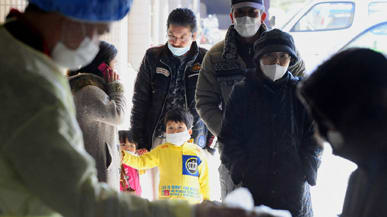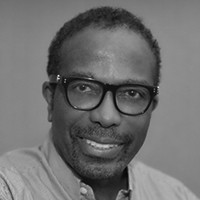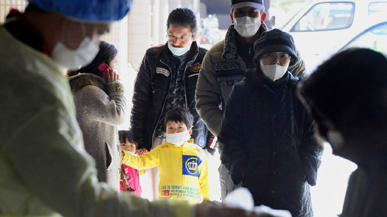Despite the ongoing nuclear crisis at the Fukushima Daiishi nuclear plant—officials are now considering burying the damaged nuclear reactors—Japanese Prime Minister Naoto Kan has vowed that the country will rebound. " We will rebuild Japan from scratch," he said in a nationally televised address, comparing the work with the country's emergence as a global power from the wreckage of World War II. “In our history, this small island nation has made miraculous economic growth thanks to the efforts of all Japanese citizens. That is how Japan was built.” The earthquake has left more than 6,900 dead so far, exceeding the 1995 Kobe earthquake that killed 6,400. (Officials estimate that more than 10,000 could be dead since 10,700 people are still missing.) In addition, more than 452,000 people were made homeless by the quake, about 343,000 households have lost electricity, and about 1 million homes have no water.
The Daily Beast's Lennox Samuels reports from Japan on the lack of good news for survivors. Plus, how Japan’s mafia is helping relief efforts and full coverage of the Japan disaster.
Chaos is emerging as the main result of Japan’s continuing all-out drive to end, or at least defuse, the nuclear crisis that has gripped the nation, and world, for the past week. On Friday, Japanese authorities raised the nuclear alert level to 5 on a scale that maxes out at 7, the U.N. atomic chief described the effort to cool down a nuclear reactor as “racing against the clock,” and authorities reported more steam at one reactor and some structural damage at another. Japanese Prime Minister Naoto Kan described the situation as “very grave.”

The cacophonous news reports disheartened Japanese citizens who had been buoyed by indications that a Thursday operation using helicopters to cool the Unit 3 reactor at the Fukushima Daiichi nuclear plant was working. But it remained unclear how much that effort has improved the overall situation, Chief Cabinet Secretary Yukio Edano said the operation using two Chinook choppers and a number of fire trucks had raised water levels at the reactor, but did not reveal what the impact was or would be. The Defense Ministry could only say it believes the water—up to 50 tons—had entered the building that houses the reactor.
Raising the nuke level to 5 does not have any immediate practical result, apart from heightening the alarm many Japanese have begun to express. Technically, a Level 4 event has local consequences and a Level 5 has “wider” consequences. The Three Mile Island incident in 1979 was a Level 5. Ukraine’s Chernobyl accident in 1986 rated a 7. Yukiya Amano, director general of the International Atomic Energy Agency, and himself Japanese, made the “ racing against the clock” comment to reporters in Tokyo. "This is not something that just Japan should deal with, and people of the entire world should cooperate with Japan and the people in the disaster areas," he said.
The comments, combined with the lack of good news, will undoubtedly lengthen the lines of people rushing to leave what has becoming an ever-widening concentric circle around Fukushima Daiichi. An estimated 500,000 people have now been displaced, about one-firth of them children. An almost nonstop stream of refugees has been descending on evacuation centers, mostly north of the nuclear danger zone, in such prefectures as Niigata, Saitama, Ibaraki, Miyagi, and Yamagata, Refugee migration in Miyagi, a prefecture hard-hit by the quake and tsunami that struck last Friday, was somewhat circular: people from farther south have been moving to centers there, even as local displaced residents fled, mostly to Yamagata. Fukushima prefecture also set up centers—for people wishing to put distance between them and the stricken plant located down the road in their own state.
The approximately 500 people who packed the Yamagata City Sports Center on Thursday had swelled to 1,000 less than 24 hours later. Most of the refugees streamed in from Fukushima prefecture, and many were trying to get away from a radiation threat. The manager of the center, Masashi Iwata, said 1,000 people is about the maximum the facility can accommodate, and that he would be concerned if the number continued to rise, which seemed certain. Families continued to walk in Friday night: parents armed with a few belongings, and children clutching blankets and pillows. At the main interior entrance, a man brandished a meter that checked the new arrivals for radiation as they registered. He said he has not found any “abnormalities”—so far.
Masakuni Shishido fled Souma, a city in Fukushima prefecture, with his sons, Shuto, 8, and Shota, 3, driven by a fear of radiation poisoning. “My kids have their own future, so I have to do something to avoid exposing them to the radiation,” he said. Yukari Kanno, in her early 20s, also came from Souma, along with some relatives. Her house was situated facing the sea, and was washed away by the tsunami. Her family subsists on fishing. She is among those who blame the Kan administration for the nuclear nightmare they are living. “The government should have been able to control the nuclear situation,” she said. “Now I am very angry at the nuclear plants, as they drove my family and friends apart.”
Among the hundreds of Japanese camped on blankets and sheets in the small rectangular acreage each family was assigned, “Solomon” stood with his wife and two little girls, ages 2 and 3, looking dazed. The tight little family, hails from Akure, Nigeria. Solomon, who did not want to give his full name, is pursuing a Ph.D in electrical engineering —ultrasound imaging, he said dully—at Tohoku University in battered Sendai city and has been in Japan three years, having brought over the rest of the family two years ago. He was in the laboratory when the quake hit and rushed out into the snow, losing his slippers along the way. “We didn’t know where to go,” he said. “We thought about Tokyo, but they are having shocks, too. Actually, my wife is still in shock.”
His children, however, ran about merrily, making new friends and helping themselves to food provided by the prefecture. They were oblivious to the conditions in the center, seeing it as just a new place to play,
That was the attitude of many of the children in centers, including a trio who incorporated the temblor into their play: They built miniskyscrapers out of Lego blocks and then dashed them to the ground, in pieces, laughing and shouting “earthquake, earthquake!”
In Yonezawa City, authorities have set up a shelter at the Civic Gymnasium, which was quickly taken over by more than 500 people, mostly from Miyagi and Fukushima. Tomoyuki Kato, director of the city’s Department of Social Education, and manager of the shelter, told The Daily Beast his main preoccupation is keeping the refugees warm. Indeed, the space usually filled with kids playing basketball was freezing, and small groups huddled around stoves and space heaters. Elsewhere, others watched the news on a flat-screen TV, played cards and challenged each other at videogames, passing the time while their lives remain on hold.
Sisters Akiko Abe and Yukie Abe watched their small children playing as they discussed their decampment from Kouriyama, a city in Fukushima prefecture. They came to Yonezawa, they said, because they worry about the kids. “The government gave us no direction on what to do with children in this nuclear crisis, so we do not know what to do at all,” said Akiko.” The most fearful thing for us is to expose our children to the radiation. We adults are OK to get exposed, but they are the future generation. We never know what will happen to us and where to go from here, and we can never go back to our city. The earthquake broke my home and we cannot live there anymore. We are forced to evacuate this far.”
Some displaced people have been able to stay with relatives, or even in hotels. The Hills San Pia Hotel in Yamagata City is temporary home to rescue workers and a few dozen refugees, among them 96-year-old Takeko Igari. She came north from Tomioka town in Fukushima. She drove with relatives and reached the city after a couple of days. ”This reminds me of the [second world] war period that we were bombed and rushed to a shelter,” she said over breakfast.
Yoshino Abe, 85, was eating with her friend, Yoshiko Akitsu, also 85. She is more fortunate than the new arrivals. She lives in the city and sometimes visits the hotel to rest. She watched the room with concern etched on her face. “It is terrible that the disaster of earthquake and tsunami was added to by the nuclear crisis,” she said. “I worry that supplies are disappearing even in this city. During the war, the Yamagata area was not heavily damaged—those things like the Hiroshima and Nagasaki atomic-bombings and its survivors seemed far away from me. Now we worry about radiation.”
On television, Prime Minister Kan said the situation “must be resolved” and that every government institution is working toward that goal. “In the not-so-distant future, the overall situation will be controlled and we will emerge from this crisis,” he said at a press conference. For the growing number of his constituents packed into evacuation centers, that future seems all too distant.
With Toshiyuki Chiku
Lennox Samuels is a Newsweek/Daily Beast editor based in Bangkok. He covered the 2004 Indian Ocean tsunami.

